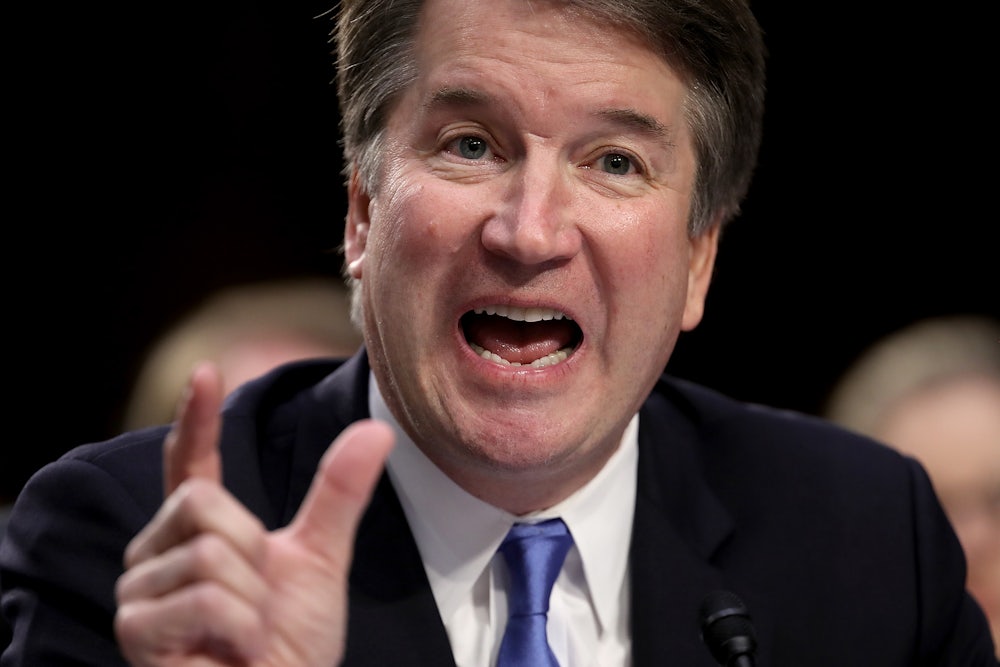Brett Kavanaugh’s answers to senators on abortion rights during his confirmation hearing on Wednesday could be summed up in two words: “I understand.” President Donald Trump’s nominee to replace retiring Supreme Court Justice Anthony Kennedy repeated that phrase over and over again to the Senate Judiciary Committee to deflect questions about Roe v. Wade and other abortion-related cases. Nonetheless, his answers suggested how he may treat the issue if confirmed to the nation’s highest court.
Democratic Senator Dianne Feinstein began her line of questions on the matter by citing her experiences with women who had abortions in the pre-Roe era. “I don’t want to go back to those death tolls in this country,” Feinstein said. “And I truly believe that women should be able to control their own reproductive systems within, obviously, some concern about the viability of the fetus.”
Kavanaugh’s response conveyed a non-committal sort of empathy. “I understand your point of view on that, senator, and I understand how passionate and how deeply people feel about this issue,” he said. “I understand the importance of the issue. I understand the importance that people attach to the Roe v. Wade decision, to the Planned Parenthood v. Casey decision. I don’t live in a bubble. I understand. I live in the real world. I understand the importance of the issue.”
In everyday conversations, “I understand” can convey a sense of empathy, which may or may not have been Kavanaugh’s intent. Repeating it six times in a single answer drains the phrase of its emotional context, however. “Do you agree with Justice [Sandra Day] O’Connor that a woman’s right to control her reproductive rights affects her ability to ‘participate equally in the economic and social life of the nation’?” Feinstein also asked Kavanaugh, quoting from the Supreme Court’s decision in Planned Parenthood, the 1993 case that replaced Roe’s trimester framework and instead said states couldn’t impose an “undue burden” on a woman’s right to obtain an abortion.
“As a general proposition, I understand the importance of the precedent set forth in Roe v. Wade,” Kavanaugh said. “It has been reaffirmed many times over the past 45 years.” The reply did not come close to answering Feinstein’s question in a literal or figurative sense. He didn’t even engage with the question. It was the rhetorical equivalent of asking someone if they enjoyed their vacation and being told about tourism’s impact on the American economy.
In July, I noted that the post-Kennedy Supreme Court could take a range of approaches to curtailing abortion rights in the years to come, the most impactful being to overrule Roe in its entirety whenever the court next hears an abortion-related case. But the court could also take a less dramatic approach. One method to reduce the availability of abortions would be to leave the Roe-Casey framework intact, then decline to rule that any state-level restrictions amount to an “undue burden” on a woman’s right to obtain one. The court’s four conservative members sought such a ruling already in Whole Women’s Health v. Hellerstadt in 2016, but Kennedy sided with the court’s liberals to strike down a slate of restrictive measures in Texas.
At one point, Kavanaugh dropped the “I understand” phrasing but continued to offer a CliffsNotes version of major Supreme Court rulings on abortion. Most of his explanation centered on how the court reframed its abortion-related precedents in Casey, setting up a framework that forestalled a four-justice bid to overturn Roe but allowed greater regulations and restrictions of the practice.
“I said that it’s settled as a precedent of the Supreme Court entitled to respect under the principles of stare decisis,” he said, referring to the legal principle of relying on judicial precedent. “One of the important things to keep in mind about Roe v. Wade is that it’s been reaffirmed many times over the past 45 years, as you know, and most prominently, most importantly, reaffirmed in Planned Parenthood v. Casey in 1992. And as you know, when that case came up, the Supreme Court didn’t just reaffirm it in passing. The court specifically went through all the factors of stare decisis in considering whether to overrule it. And the joint opinion by Justice Kennedy, Justice O’Connor, and Justice Souter at great length went through those factors, that was the question presented in the case.”
This isn’t conclusive evidence that Kavanaugh, who serves on the U.S. Court of Appeals for the D.C. Circuit, will join with the court’s conservative wing to curtail abortion rights, but it isn’t a huge imaginative leap. His dissent last year in Garza v. Hargan, in which he opposed a ruling that allowed an undocumented teenage immigrant to leave federal custody to obtain an abortion, already indicated a willingness to interpret existing precedent more narrowly than his colleagues. And the most telling indicator is how the biggest stakeholders on the issue are treating Kavanaugh’s nomination. Anti-abortion groups like the Susan B. Anthony List and the Pro-Life Action League are waging an all-out campaign to support his confirmation, while abortion-rights groups are fighting tooth and nail to keep him off the court. Neither side knows his exact views on abortion, of course. But they understand.
